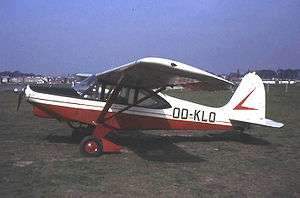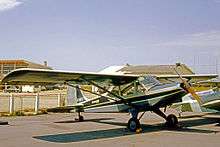Boisavia Mercurey
| B.60 Mercurey | |
|---|---|
 | |
| Role | Civil utility aircraft |
| National origin | France |
| Manufacturer | Boisavia |
| First flight | 3 April 1949 |
| Number built | 46 |
|
| |
The Boisavia B.60 Mercurey was a series of four-seat light aircraft developed in France shortly after World War II.
Design and operations

Boisavia B.601L Mercurey of Omniair at Dijon's Val Suzon airfield in 1965
The Mercurey was a conventional high-wing braced monoplane with fixed tailwheel undercarriage. It was built in small numbers and found use in the normal general aviation roles of tourer, trainer, agricultural aircraft, and glider tug.
Variants
- B.60 Mercurey
- 3 prototypes powered by 100 kW (140 hp) Renault 4Pei engine
- B.601 Mercurey
- Powered by a 140 kW (190 hp) Avco Lycoming O-435-1 engine (3 built)
- B.601L Mercurey
- Main production version, equipped with an 130 kW (180 hp) Avco Lycoming O-360-A engine (27 built)
- B.602 Mercurey
- Powered by a 123 kW (165 hp) Continental E165-4 engine (2 built)
- B.602A
- 1x 159 kW (213 hp) Continental O-470-11
- B.603 Mercurey Special
- Glider tug version, powered by a 180 kW (240 hp) Salmson 8 As engine (5 built)
- B.604 Mercurey II
- Dedicated glider tug with lengthened fuselage, powered by a 170 kW (230 hp) Salmson 9ABc radial piston engine (1 built)
- B.605 Mercurey
- Similar to the B.60 Mercury, powered by a 130 kW (170 hp) Regnier 4L-O2 (SNECMA 4L-02) engine, (4 built).
- B.606 Mercurey
- 130 kW (170 hp) Regnier 4L-O0 (SNECMA 4L-00) engine (1 built)
Specifications (B.60)
Data from Jane's All The World's Aircraft 1953–54[1]
General characteristics
- Crew: one pilot
- Capacity: 3 passengers
- Length: 7.10 m (23 ft 3 in)
- Wingspan: 11.38 m (37 ft 4 in)
- Height: 2.10 m (6 ft 10 in)
- Wing area: 18.0 m2 (194 ft2)
- Empty weight: 520 kg (1,146 lb)
- Gross weight: 1,000 kg (2,205 lb)
- Powerplant: 1 × Renault 4Pei 4-cylinder air-cooled inline engine, 104 kW (140 hp) each
Performance
- Maximum speed: 235 km/h (146 mph)
- Cruising speed: 190 km/h (118 mph)
- Range: 1,100 km (684 miles)
- Service ceiling: 5,500 m (18,045 ft)
- Rate of climb: 4.0 m/s (790 ft/min)
References
| Wikimedia Commons has media related to Boisavia. |
- ↑ Bridgman 1953, p. 126.
- Bridgman, Leonard (1953). Jane's All The World's Aircraft 1953–54. London: Jane's All The World's Aircraft Publishing Company.
- Simpson, R. W. (1995). Airlife's General Aviation. Shrewsbury: Airlife Publishing. pp. 408–09.
- Taylor, Michael J. H. (1989). Jane's Encyclopedia of Aviation. London: Studio Editions. p. 192.
- World Aircraft Information Files. London: Bright Star Publishing. pp. File 890 Sheet 73.
This article is issued from Wikipedia - version of the 6/23/2015. The text is available under the Creative Commons Attribution/Share Alike but additional terms may apply for the media files.
